When choosing your perfect outdoor flat top griddle, you’ll need to take into account five key factors. First, select the cooking surface size based on your typical group—small griddles handle 9-16 burgers while XL models cook up to 48. Choose between propane for mobility or natural gas for stationary setups. Prioritize models with even heat distribution and quality grease management systems. Balance your budget against premium features like multiple burners and digital controls for peak performance.
Understanding Different Types of Outdoor Flat Top Griddles
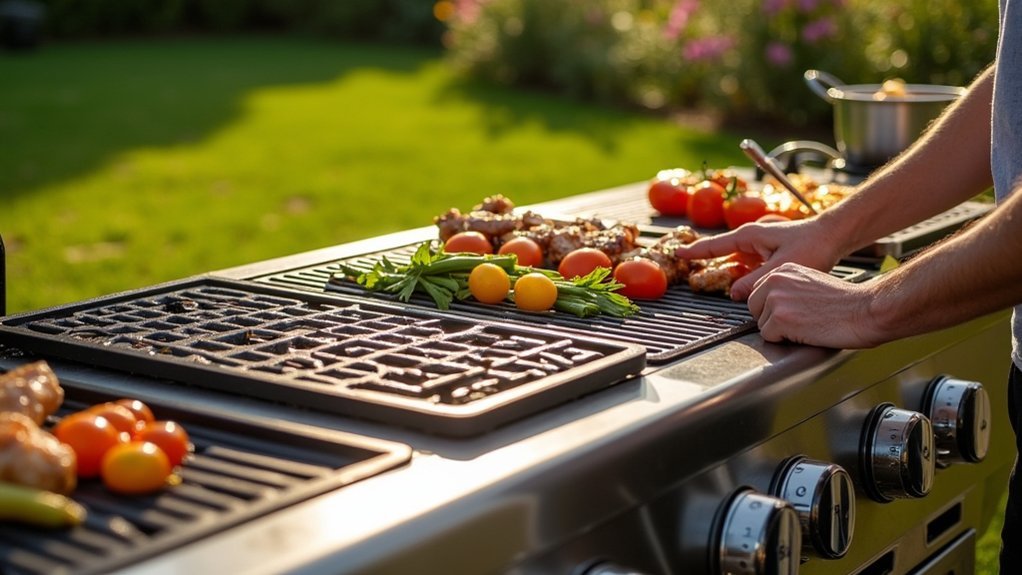
When you’re shopping for an outdoor flat top griddle, you’ll encounter three main configurations that cater to different cooking scenarios and space requirements.
Freestanding outdoor griddles offer maximum mobility and can be positioned anywhere in your outdoor space. Built-in models integrate seamlessly into outdoor kitchens for a permanent, professional appearance. Portable versions provide ultimate flexibility for camping or tailgating adventures.
Each configuration affects your fuel choice between propane tank systems for mobility or natural gas for fixed installations.
Consider how the burner configuration impacts heat distribution across your cooking surface. Additionally, evaluate grease management systems, as they vary considerably between models.
Understanding these fundamental differences helps you select the right griddle type that matches your specific outdoor cooking needs and space constraints.
Determining the Right Cooking Surface Size for Your Needs
How much cooking space do you actually need for your outdoor griddle? Your cooking surface area depends entirely on your typical gathering size and cooking habits.
Small griddles up to 26 inches wide handle 9-16 burgers, perfect for intimate family meals or tailgating adventures.
Medium-sized griddles spanning 27-33 inches provide ample space for larger families and accommodate versatile meals without overcrowding your ingredients. You’ll cook more efficiently with better heat distribution across the surface.
Large models stretching 34-42 inches accommodate up to 40 burgers, making them ideal for large gatherings and events.
An XL flat top grill reaches 48 inches wide with seven burners, handling 48 burgers simultaneously. These massive units cater to extensive outdoor cooking needs, ensuring you’ll never run out of space when feeding crowds.
Evaluating Heat Distribution and Temperature Control
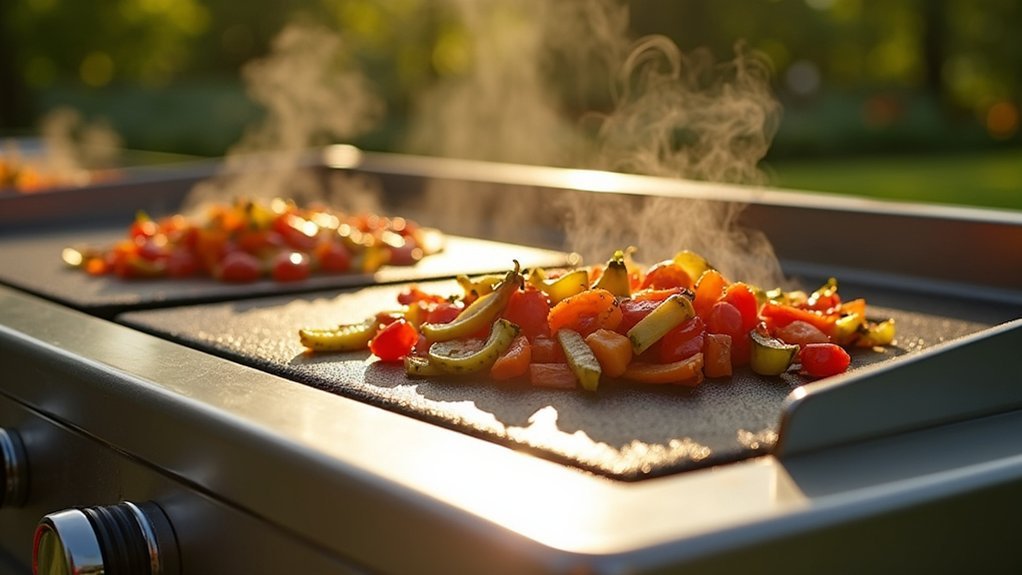
Three critical factors determine your griddle’s cooking performance: heat distribution, temperature control, and wind resistance. Even heat across the surface eliminates hot spots that create inconsistent results. Models like Traeger and Weber excel at maintaining uniform cooking temperatures, while others like Grilla Primate show uneven patterns during bread tests.
| Feature | Top Performers | Poor Performers |
|---|---|---|
| Heat Distribution | Traeger, Weber | Grilla Primate, Camp Chef |
| Wind Resistance | Traeger Flatrock | Blackstone, Pit Boss |
| Temperature Control | Multi-burner models | Single-zone griddles |
You’ll want multiple heat zones for versatile cooking—imagine pancakes cooking gently while bacon sizzles at higher temperatures. More burners provide better BTU distribution and superior temperature control across larger surfaces, giving you the flexibility to cook different foods simultaneously.
Choosing Between Propane and Natural Gas Fuel Options
When selecting your outdoor flat top griddle, you’ll need to decide between propane and natural gas as your fuel source.
Each option offers distinct advantages that can greatly impact your cooking experience and setup requirements.
Your choice should align with how often you’ll cook, where you plan to use the griddle, and what fuel connections are available at your location.
Propane Vs Natural Gas
Where you plan to use your outdoor cooking will largely determine whether propane or natural gas makes the most sense for your setup.
Propane offers superior mobility with standard 20 lb tanks, perfect for tailgating or camping adventures. You’ll also get higher heat output for fast, high-temperature grilling.
However, natural gas provides continuous fuel supply without tank refills, though it requires professional installation by a licensed plumber for permanent setups.
Consider your cooking habits when deciding. If you’re frequently outdoor cooking at home, natural gas proves more cost-effective long-term.
But if portability matters or you lack permanent outdoor kitchen space, propane’s flexibility wins.
Propane burns hotter but costs more per BTU, while natural gas offers convenience and economy for stationary installations.
Fuel Source Considerations
Fuel selection fundamentally shapes your outdoor griddle experience, affecting everything from setup complexity to ongoing operational costs.
When choosing your fuel source, you’ll need to weigh mobility against convenience. Propane offers unmatched flexibility with portable tanks, letting you cook anywhere without permanent installation. You’ll simply connect a standard 20-pound tank and start grilling. However, you’ll need to monitor fuel levels and arrange refills or exchanges.
Natural gas eliminates tank management entirely, providing continuous fuel supply through a permanent connection. Licensed plumbers must handle installation, making this option location-specific.
While propane typically delivers higher BTUs for faster heating, natural gas proves more economical for frequent use.
Consider your cooking frequency, preferred locations, and whether you value portability over permanent convenience when selecting between these fuel options.
Assessing Wind Resistance and Weather Performance
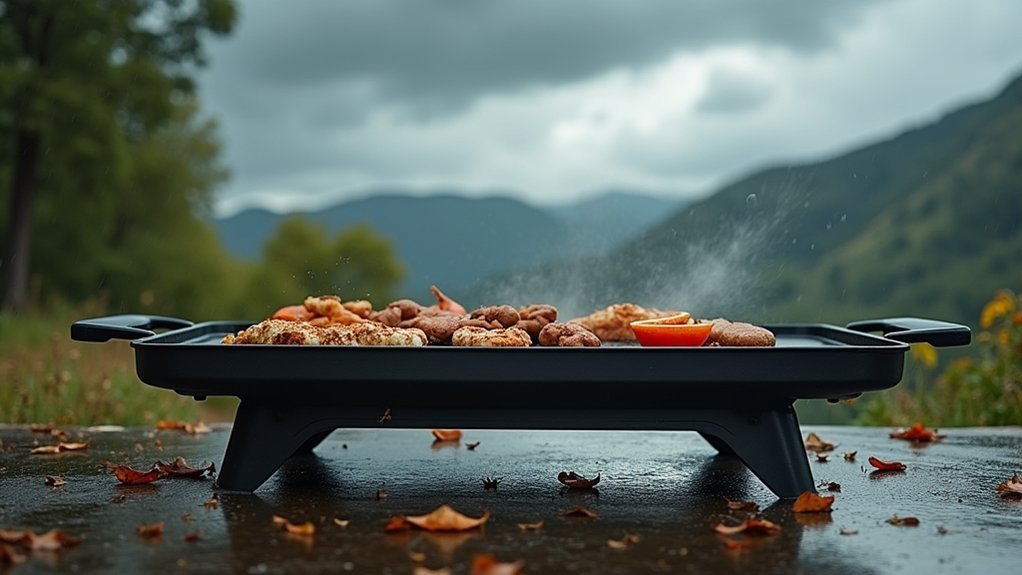
Although many outdoor cooking enthusiasts focus primarily on heat output and cooking surface size, wind resistance often determines whether you’ll achieve consistent results or struggle with uneven cooking temperatures.
Your griddle’s design greatly impacts how well it performs in breezy conditions.
When evaluating wind performance, consider these key factors:
- Recessed cooking surface design – Models like the Traeger Flatrock protect against wind better than exposed surfaces.
- Gap between burners and cooking surface – Smaller gaps reduce heat loss during windy conditions.
- Sturdy construction with substantial side shelves – Enhances overall stability and cooking consistency.
- Proven wind testing results – The Grilla Primate and Weber Slate demonstrated reliable performance under simulated wind conditions.
Don’t overlook this vital factor when making your selection.
Grease Management Systems and Cleanup Features
While impressive heat output might draw your attention initially, a well-designed grease management system will make or break your outdoor cooking experience. You’ll want a griddle with a built-in grease trap that channels excess grease away from the cooking surface, preventing dangerous flare-ups and messy cleanup situations.
| Feature | Benefit |
|---|---|
| Large removable grease buckets | Quick disposal and easy access |
| Recessed grease management systems | Wind and debris protection |
| Disposable liners for drip trays | Simplified post-cooking cleanup |
| Accessible grease trap design | Straightforward maintenance |
| Built-in channeling systems | Prevents surface mess |
Look for models offering disposable liners, which guarantee hygienic cooking experiences. Regular cleaning prevents clogs and maintains peak performance, so prioritize griddles designed for easy access to grease management components.
Storage Space and Prep Area Requirements
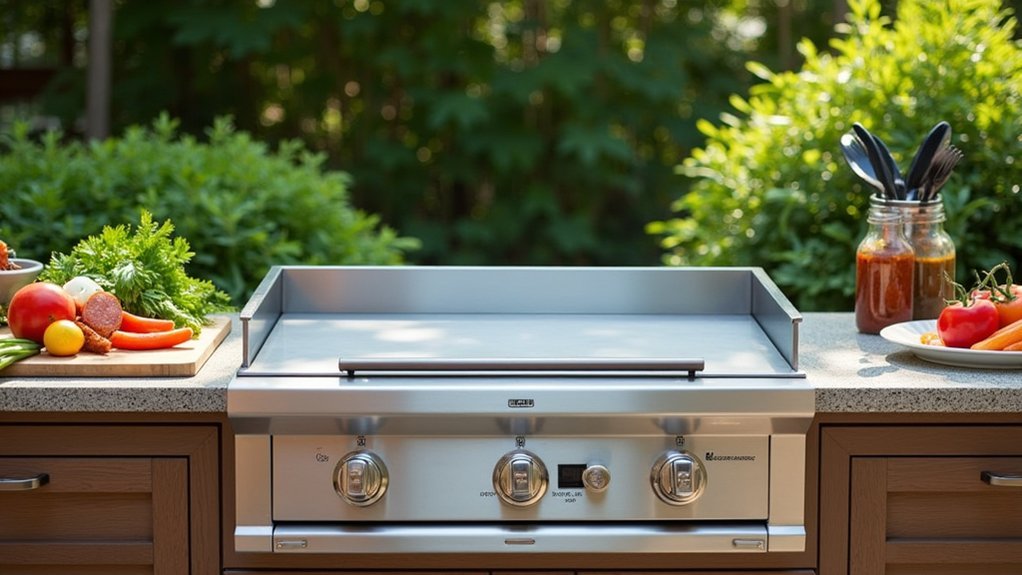
Organization becomes your best friend when cooking on a flat top griddle, where the fast-paced nature demands everything be prepped and within arm’s reach before you fire up the surface.
Organization is your secret weapon for flat top griddle success – prep everything beforehand or watch your cooking turn chaotic.
You can’t afford to leave food unattended while searching for tools or ingredients.
Here’s what you need for ideal prep space and organization:
- Large side shelves – Essential for keeping utensils and ingredients accessible without requiring additional tables.
- Minimum 540 square inches cooking space – Accommodates meals for 4-6 people with room for multiple items.
- Storage bins – Keep seasonings, oils, and tools organized and protected from wind.
- Wind-protected layout – Position your griddle to shield your prep space from gusty conditions.
Regular cleaning and maintenance of your prep area guarantees smooth cooking sessions and maintains a safe, efficient workspace.
Seasoning and Maintenance Considerations
Your griddle’s cooking surface will determine how much maintenance you’ll need to commit to over its lifetime.
Carbon steel surfaces require initial seasoning with multiple oil layers before first use, while stainless steel griddles are ready to cook immediately.
You’ll also need to establish daily cleaning routines and proper storage methods to protect your investment from rust and deterioration.
Pre-Use Seasoning Requirements
Before you fire up your new outdoor flat top griddle, understanding the seasoning requirements will determine whether you’re ready to cook immediately or need to invest time in preparation.
Carbon steel griddles need pre-use seasoning to develop a non-stick surface and protective coating, while stainless steel models don’t require this step.
Here’s your seasoning process:
- Apply oil layer – Coat the entire cooking surface with high-heat oil
- Heat to high temperature – Follow your manufacturer’s manual for specific temperatures
- Repeat multiple times – Build up layers for ideal cooking quality
- Maintain after each use – Reseason with oil to prevent rust and maintain performance
Proper seasoning creates a smoother cooking surface, prevents food from sticking, and enhances flavor retention for better outdoor cooking experiences.
Daily Cleaning Protocols
After establishing your griddle’s protective coating, maintaining that seasoning depends on proper daily cleaning habits.
You’ll want to scrape debris from the griddle surface into the drip tray using a metal spatula, then rinse with water to loosen stuck-on food particles.
For carbon steel griddles, never use soap as it’ll strip away your carefully built seasoning. Instead, use water and an abrasive scrub tool to clean effectively while preserving the non-stick cooking surface.
After cleaning, you must season the surface with oil to prevent rust and maintain ideal cooking performance.
Don’t forget to regularly clean your drip tray to prevent buildup and guarantee proper drainage during cooking sessions.
Long-Term Storage Protection
When you’re storing your outdoor griddle for extended periods, proper preparation becomes critical for preventing rust and maintaining your seasoning investment.
Whether you own carbon steel or stainless steel, protection strategies differ considerably but remain equally important.
Here’s your long-term storage checklist:
- Apply fresh seasoning layers to carbon steel griddles using oil before storage to create maximum rust protection.
- Clean thoroughly without soap for carbon steel surfaces, or deep-clean stainless steel griddles to prevent corrosion from food residues.
- Choose a completely dry storage location away from moisture sources that could compromise your griddle’s surface.
- Use protective covers and conduct periodic inspections during storage to catch any damage or wear early.
Proper storage preparation guarantees your griddle’s ready for immediate use when grilling season returns.
Budget Vs Premium Features Comparison
While budget flat top griddles ranging from $200 to $400 can meet basic outdoor cooking needs, premium models costing $500 and above deliver markedly enhanced performance and durability that justify their higher price point.
Budget options typically offer 2-4 burners with 24,000-48,000 BTUs, while premium griddles feature 4-5 burners exceeding 60,000 BTUs for superior heat distribution. You’ll find basic grease management systems in budget models versus advanced rear grease management in premium versions for easier cleanup.
| Feature | Budget ($200-$400) | Premium ($500+) |
|---|---|---|
| Burners | 2-4 burners | 4-5 burners |
| BTU Output | 24,000-48,000 | 60,000+ |
| Warranty | 1-2 years | Up to 5 years |
| Additional Features | Basic controls | Digital displays, larger shelves |
Premium features include digital temperature displays, robust construction materials, and extended warranties up to five years compared to budget models’ 1-2 year coverage.
Installation Options: Freestanding Vs Built-In Models
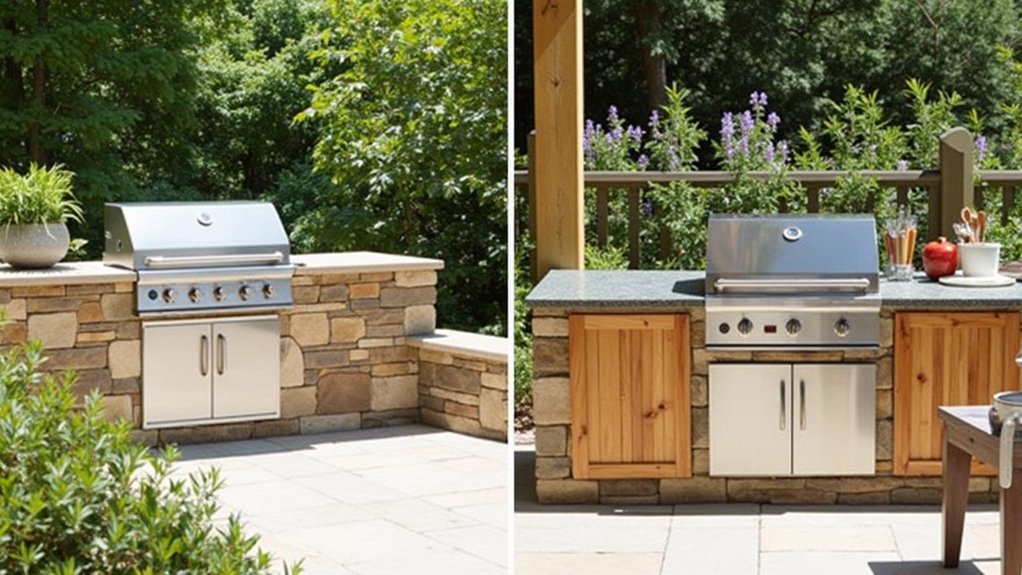
You’ll need to decide between a freestanding griddle that offers maximum flexibility or a built-in model that creates a permanent outdoor cooking station.
Freestanding units give you the freedom to move your griddle wherever you need it, whether that’s following the shade or taking it to a friend’s house.
Built-in installations require more planning and often professional help, but they’ll transform your outdoor space into a true culinary destination.
Freestanding Griddle Benefits
If you’re looking for maximum flexibility in your outdoor cooking setup, freestanding griddles deliver unmatched versatility that built-in models simply can’t match.
These portable units transform your outdoor cooking experience with their mobility and convenience.
The portability advantages make freestanding griddles perfect for various cooking scenarios:
- Easy relocation – Wheeled carts let you move your griddle anywhere in your backyard, patio, or even camping locations.
- Quick setup – Minimal installation means you’ll be cooking immediately without professional help.
- Flexible positioning – Place your griddle wherever works best for your outdoor kitchen layout.
- Enhanced workspace – Spacious side tables provide ample prep space for ingredients and cooking tools.
You’ll appreciate the freedom to redesign your outdoor space without permanent commitments.
Built-In Installation Considerations
Before committing to a built-in griddle installation, you’ll need to evaluate several vital factors that determine whether your outdoor space can accommodate this permanent installation.
First, make sure you have access to a natural gas line or plan for professional gas line installation to your desired location. Proper ventilation is essential for safety and performance, requiring adequate clearance around the built-in griddle for airflow and heat dissipation.
You must also verify compliance with local building codes, which vary by municipality and often dictate specific requirements for outdoor cooking appliances.
Consider the griddle’s proximity to your home’s structure, property lines, and other outdoor features. Professional installation guarantees proper connections and adherence to safety standards, making this investment both functional and compliant.
Essential Accessories and Add-Ons to Consider
Several key accessories can transform your outdoor flat top griddle from a basic cooking surface into a complete outdoor kitchen station.
These add-ons enhance functionality, protect your investment, and expand your cooking capabilities.
Consider these essential accessories for your griddle setup:
- Protective covers – Invest in durable covers to shield your griddle from moisture and rust, considerably extending its lifespan through weather protection.
- Side shelves and tool holders – Add prep space and magnetic tool storage for easy utensil access during cooking sessions.
- Grease management accessories – Install built-in grease traps or additional drainage systems to minimize mess and simplify cleanup.
- Cast iron cookware and temperature control tools – Enhance versatility with skillets and digital thermometers for precise cooking and improved heat retention across various dishes.
Frequently Asked Questions
What to Look for When Buying an Outdoor Griddle?
You’ll want adequate cooking surface area, multiple burners with high BTUs, comfortable height, efficient grease management, and wind-resistant performance. Consider models that can handle 18 pancakes and excel in breezy conditions.
What Is the Best Material for a Flat Top Griddle?
Steel’s your best bet for durability and versatility. Carbon steel develops excellent non-stick properties when seasoned, while stainless steel’s easier to maintain. Ceramic offers effortless cleanup but scratches easily, so choose based on your cooking priorities.
Is There a Griddle That Doesn’t Warp?
You can’t find a completely warp-proof griddle, but high-quality stainless steel models like Le Griddle’s Ranch Hand and thick-surfaced options like Traeger’s Flatrock resist warping through superior construction and materials.
Which Is Better for a Griddle, Stainless Steel or Cast Iron?
Cast iron’s better if you prioritize heat retention and high-temperature cooking, but stainless steel wins for easy maintenance and durability. Choose cast iron for performance, stainless steel for convenience and longevity.
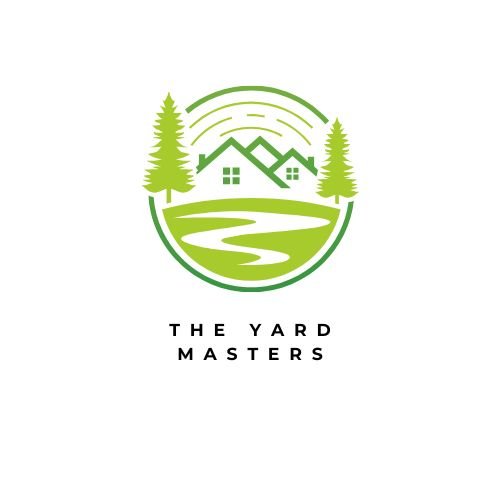
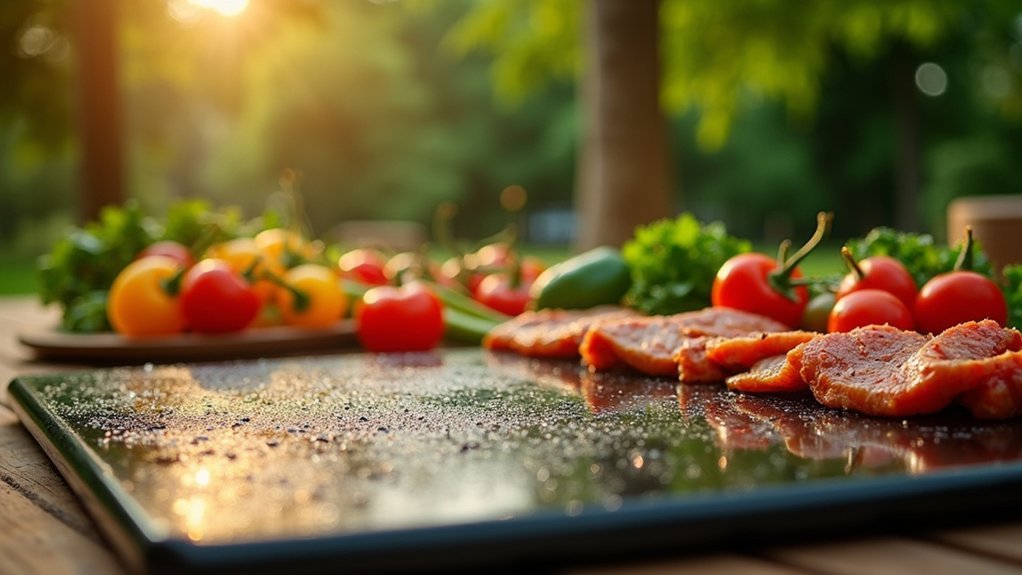



Leave a Reply